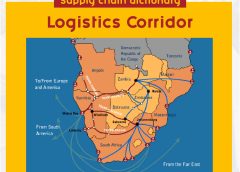A logistics corridor is a route or itinerary designed to optimize the movement of goods from their point of origin to their final destination. This corridor integrates multiple modes of transport such as roads, railways, waterways, and seaports, and uses specialized logistics infrastructure and services to ensure an efficient, fast, and secure supply chain.
Benefits of Logistics Corridors
- Optimization of the Supply Chain:
-
- Reduces transit times and transportation costs through optimized routes.
- Improves logistics operations efficiency by better coordination between different modes of transport.
- Reduction of Logistics Costs:
-
- Minimizes handling, storage, and transportation costs by integrating specialized logistics services.
- Offers economies of scale by using corridors shared by multiple companies.
- Improvement of Regional Connectivity:
-
- Strengthens links between production areas, distribution centers, and consumer markets.
- Facilitates interregional trade by reducing logistical barriers.
- Promotion of Economic Development:
-
- Stimulates the local economy by attracting investments in infrastructure and logistics services.
- Creates jobs and improves local economic opportunities.
- Enhancement of Security and Reliability:
-
- Increases the security of goods in transit through improved infrastructure and management systems.
- Reduces risks of delays and goods losses.
Examples of Logistics Corridors in Africa
- North-South Corridor:
-
- Connects Durban in South Africa to Lusaka in Zambia and Lubumbashi in the Democratic Republic of Congo.
- Used for transporting minerals, agricultural, and manufactured products, thus optimizing the supply chain from Southern to Central Africa.
- Maputo Corridor:
-
- Links Johannesburg in South Africa to the port of Maputo in Mozambique.
- Specialized in transporting mining, agricultural, and manufactured products, it has improved logistics efficiency between the two countries.
- Walvis Bay Corridor:
-
- Extends from the port of Walvis Bay in Namibia to Botswana, Zambia, and Zimbabwe.
- Improves logistical access for landlocked countries to international markets and reduces transportation costs.
- Central Corridor:
-
- Connects the port of Dar es Salaam in Tanzania to Kigali in Rwanda, Bujumbura in Burundi, and Kampala in Uganda.
- Facilitates the transport of minerals, coffee, tea, and other agricultural products, optimizing the supply chain in the region.
- Mombasa Corridor:
-
- Connects the port of Mombasa in Kenya to Uganda, Rwanda, and South Sudan.
- Essential for the transport of petroleum products, machinery, construction materials, and manufactured goods in the East African region.
Logistics corridors are crucial for improving the efficiency of the supply chain in Africa. They optimize logistics operations, reduce costs, improve regional connectivity, and stimulate economic development. By investing in these corridors, African countries can enhance their competitiveness in the global market and improve the living conditions of their populations.






